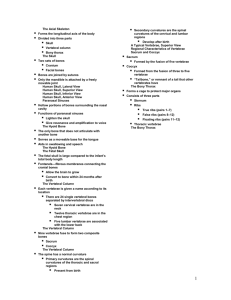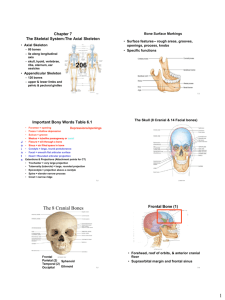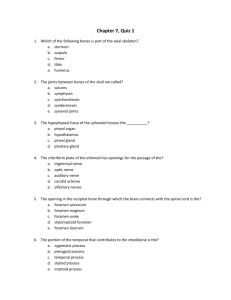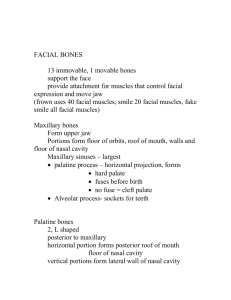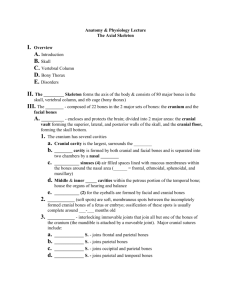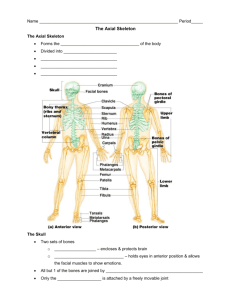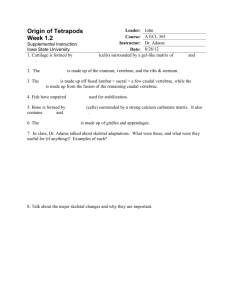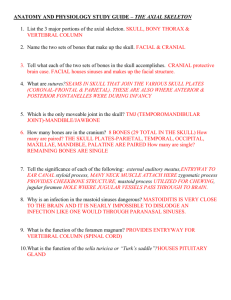THE SKELETAL SYSTEM: PART 1
advertisement
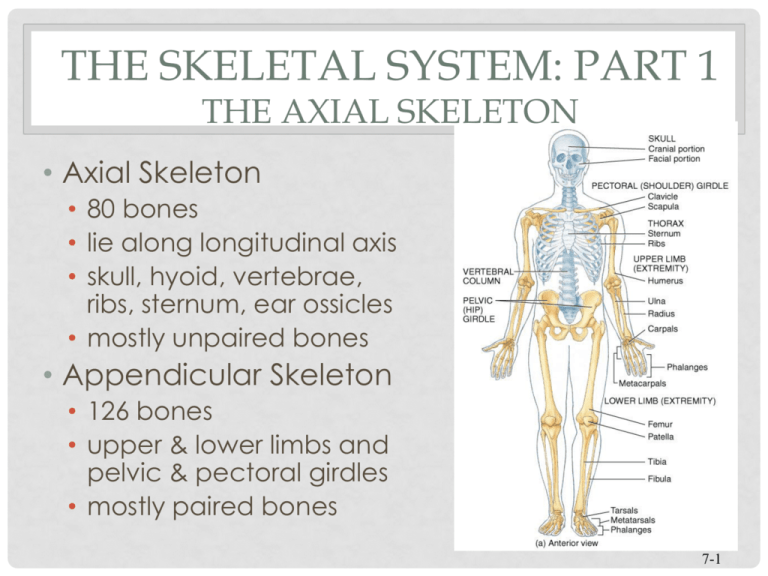
THE SKELETAL SYSTEM: PART 1 THE AXIAL SKELETON • Axial Skeleton • 80 bones • lie along longitudinal axis • skull, hyoid, vertebrae, ribs, sternum, ear ossicles • mostly unpaired bones • Appendicular Skeleton • 126 bones • upper & lower limbs and pelvic & pectoral girdles • mostly paired bones 7-1 TYPES OF BONES • 5 basic types of bones: • long = compact • short = spongy except surface • flat = plates of compact enclosing spongy • irregular = variable • sesamoid = develop in tendons or ligaments (patella) • Sutural bones = in joint between skull bones 7-2 BONE SURFACE MARKINGS • Surface features-- rough area, groove, openings, process • Specific functions • passageway for blood vessels and nerves • joint formation • muscle attachment & contraction 7-3 BONE SURFACE MARKINGS FROM TABLE 7.1 Foramen = opening Fossa = shallow depression Sulcus = groove Meatus = tubelike passageway or canal Condyle = large, round protuberance Facet = smooth flat articular surface Trochanter = very large projection Tuberosity = large, rounded, roughened projection like a knob • Spine = very high ridge • Process = prominent projection • Learning the terms found in this Table will simplify your study of the skeleton. • • • • • • • • THE SKULL • 8 Cranial bones • protect brain & house ear ossicles • muscle attachment for jaw, neck & facial muscles • 14 Facial bones • protect delicate sense organs -- smell, taste, vision • support entrances to digestive and respiratory systems 7-5 THE 8 CRANIAL BONES Frontal Parietal (2) Temporal (2) Occipital Sphenoid Ethmoid You need to know these!! 7-6 FRONTAL BONE • Forehead, roof of orbits, & anterior cranial floor 7-7 PARIETAL & TEMPORAL BONES • Parietal • sides & roof of cranial cavity • Temporal • Side of the cranial cavity (temples) • Means passage of time (grays 1st) 7-8 14 FACIAL BONES Nasal (2) Mandible (1) Maxillae (2) Lacrimal (2) Zygomatic (2) Palatine (2) Inferior nasal conchae (2) Vomer (1) You need to know these!! MAXILLARY BONES • Floor of orbit, floor of nasal cavity or hard palate • Maxillary sinus • Cleft palate is lack of union of maxillary bones 7-10 NASAL SEPTUM • Divides nasal cavity into left and right sides • Formed by vomer, perpendicular plate of ethmoid and septal cartilage • Deviated septum does not line in the midline • developmental abnormality or trauma 7-11 HYOID BONE • • • • U-shaped single bone Articulates with no other bone of the body Suspended by ligament and muscle from skull Attachment for some tongue muscles, neck and pharyngeal muscles, and lifts the larynx during speech & swallowing 7-12 FONTANELS OF THE SKULL AT BIRTH. • Dense connective tissue membrane-filled spaces (soft spots) • Unossified at birth but close early in a child's life. • Fetal skull passes through the birth canal. • Rapid growth of the brain during infancy 7-13 VERTEBRAL COLUMN • Backbone or spine built of 26 vertebrae • Five vertebral regions • cervical vertebrae (7) in the neck • thoracic vertebrae ( 12 ) in the thorax • lumbar vertebrae ( 5 ) in the low back region • sacrum (5, fused) • coccyx (4, fused) You need to know these!! 7-14 VERTEBRAL COLUMN FUNCTIONS • There are 5 major functions: • Support the weight of the head and trunk • Protect the spinal cord • Allow for exiting of spinal nerves from spinal cord • Provide a site for muscle attachment • Permit movement of the head and trunk You need to know these!! 7-15 INTERVERTEBRAL DISCS • Between adjacent vertebrae absorbs vertical shock • Permit various movements of the vertebral column 7-16 NORMAL CURVES OF THE VERTEBRAL COLUMN • Primary curves – thoracic and sacral are formed during fetal development • Secondary curves – cervical if formed when infant raises head at 4 months – lumbar forms when infant sits up & begins to walk at 1 year TYPICAL VERTEBRAE • Body • weight bearing • Vertebral arch • Vertebral foramen • Seven processes • 2 transverse • 1 spinous • 4 articular • Vertebral notches You need to know these!! Spinous Process, (2) transverse process, foramen, & body HOW DOES THE SPINE WORK? • The inferior articulation of one vertebrae sit right on top of the superior articulation of the one below it. • The Cauda Equina fits right into the vertebral foramen. • Spinal nerves branch out INTERVERTEBRAL DISKS • Pads of fibrocartilage that act as shock absorbers between the vertebrae. • 2 parts: • Annulus fibrosus- outer ring • Nucleus pulposus- pulp or gel in ring • The disks become more depressed with age and you shrink HERNIATED (SLIPPED) DISC • Protrusion of the nucleus pulposus • Most commonly in lumbar region • Pressure on spinal nerves causes pain • Surgical removal of disc 7-21 CLINICAL PROBLEMS • Abnornal curves of the spine. • scoliosis (lateral bending of the column) • kyphosis (exaggerated thoracic curve)hump • lordosis (exaggerated lumbar curve) swayback • Spina bifida is a congenital defect • failure of the vertebral laminae to unite • nervous tissue is unprotected • paralysis THORAX • Bony cage flattened from front to back • Sternum (breastbone) • Ribs • 1-7 are true ribs (vertebrosternal) • 8-12 are false ribs (vertebrochondral) • 11-12 are floating • Costal cartilages • Bodies of the thoracic vertebrae. You need to know these!! 7-23 RIBS Fracture at site of greatest curvature. • Intercostal spaces contain intercostal muscles WHAT DO I NEED TO KNOW • • • • • • • Axial vs. Appendicular General understanding of bone feature terms 8 cranial bones 14 facial bones Sections of the spinal column 4 parts of a vertebrae (body, processes, foramen) Types of ribs and sternum
